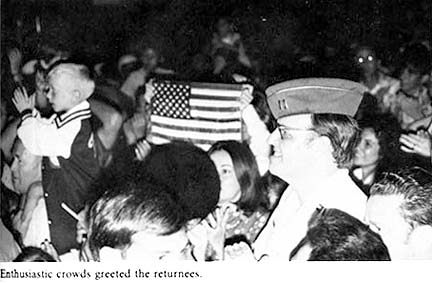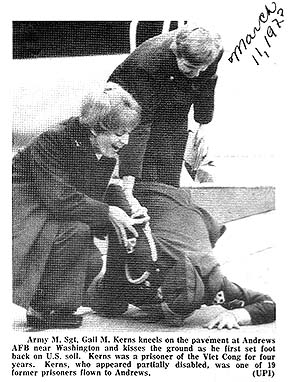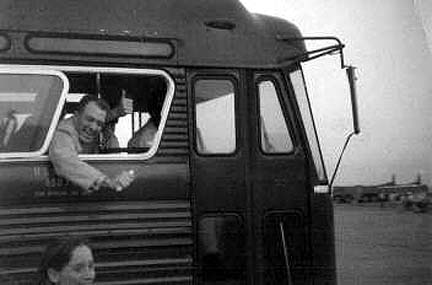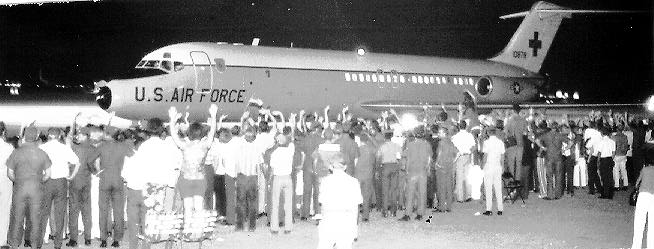|
Posted on 06/11/2003 3:23:49 AM PDT by snippy_about_it
|
|
 are acknowledged, affirmed and commemorated.
|

| Our Mission: The FReeper Foxhole is dedicated to Veterans of our Nation's military forces and to others who are affected in their relationships with Veterans.
Where the Freeper Foxhole introduces a different veteran each Wednesday. The "ordinary" Soldier, Sailor, Airman or Marine who participated in the events in our Country's history. We hope to present events as seen through their eyes. To give you a glimpse into the life of those who sacrificed for all of us - Our Veterans.
|
|
|
|
In 1972-73, I was a young Air Force officer stationed at Clark Air Base in the Philippines. It was one of the largest bases in the world, and was near the combat areas of Southeast Asia.  My thanks to Larry Chesley, Lt. Col. USAF Retired, one of those who came home, for allowing me to quote liberally from his book, "Seven Years in Hanoi". Thanks also to those who have commented on the earlier version of this page for allowing me to include their comments here. They have added much to my story and understanding of this event. The images are courtesy of the U.S. Air Force.  These are C-141 aircraft, the workhorse of the airlift fleet. They can be configured as medical evacuation aircraft, including litters for more seriously ill patients. Specially trained flight nurses, and sometimes doctors, serve on these special aircra ft. Here, several C-141s are lined up at Clark, waiting for the order to fly to Hanoi to bring our men home. The red crosses on their tails indicate their mission. No, that is not Mount Pinatubo, the famous volcano; it's Mount Arayat! Barry Crocker, a young man in aircraft maintenance at Clark during Homecoming, put the red cross on the tail of the first aircraft. He remembers running around the base trying to find red tape that would be strong enough to stay on, but he said the crosses were finally painted on. Barry also was a member of the block crew for the first airplane when it returned from Hanoi and he still feels the honor! That first C-141 is still flying and has become something of a memorial.   In posed photos, several of the men demonstrate POW life in a cell and the yard at the Hanoi Hilton. The lack of historical accuracy, however, was pointed out by Gordon "Swede" Larson who said that during almost 6 years as a POW, he never saw a bed. Everyone he knew slept on a cement bunk, planks on a sawhorse, or the floor! He also said that it was only during the last year that even a couple of the men were allowed outside together, and it was only during the last few weeks that more than a few were allowed out at the same time. Larry Chesley was a young officer who had been a POW for almost eight years. In his book, "Seven Years in Hanoi", he wrote: February 12th was a beautiful day in North Vietnam, - at least to 112 American POWs. We had received our going away clothes the night before and cleaned up our rooms as well as we could. We assembled in the courtyard and made our way under g uard to the gate of the Hanoi Hilton. This was the first time we had moved anywhere from there without being blindfolded and handcuffed. These camouflaged buses carried the men to the airfield in Hanoi. Note the going away clothes: dark blue slacks, light blue shirts, a wind breaker, shoes and socks. Each also had a small bag for toiletries. The men came out in the order in which they had been captured. The first group had spent 6-8 years as prisoners of war At Hanoi's Gia Lam airfield, the men marched in military style through the crowds. Maintaining their military bearing and discipline was a key to getting through the POW experience for many, as was their religious faith.  A group of Americans moves toward freedom. It was an overcast day, but beautiful to the POWs. Awaiting the POWs at the airfield was an American military commission. Larry wrote:  How good it was to see those United States uniforms again. As a Vietnamese officer read off our names one by one . . . . . . we saluted Colonel Al Lynn, the U.S. officer in charge. He shook each of us by the hand... ...Then a U.S. military escort walked us to the plane, giving us a hug of welcome as they did so.  There was one woman POW. We Americans never heard much about her, but I believe she was a German civilian nurse. As you can see, she had the same going away clothes as the men had.  Meanwhile, in South Vietnam, another group of Americans also prepared to go home. They were prisoners of the Viet Cong, and only a very few of those POWs survived to return to freedom. They were taken to a release point in a rural area, not a city. And as you can see, they left in the pajama-style prisoner uniforms that they had worn throughout their captivity.  The men from the South definitely appeared to be in worse condition than those from the North. But their joy that day was certainly at least as great as that of their comrades from the Hanoi Hilton Wayne Everingham was an aeromedical technician during Operation Homecoming. He commented that each of the newly freed men was dressed in the same colored clothing, carried a diddy bag and wore a very somber face. But that changed immediatedly to a beaming smile as they got inside of the aircraft - they hadn't wanted the Vietnamese to see any expression! All the POWs were flown to Clark in the medevac C-141s. Larry Chesley commented:  We were met at the door by pretty young ladies, the first American women we had seen in years. We sat down in the seats and looked around. Everything seemed like heaven. Just like heaven. When the doors of that C-141 closed, there were tears in the eyes of every man aboard. I didn't know the details of this picture, but Wayne also told me this story. No one on the ground or in the aircraft had noticed the dog, but Wayne did so he asked about it. The man had zipped the dog into his diddy bag and somehow kept it quiet. It was just a stray that some of the Americans had befriended and made kind of a camp mascot. The man told Wayne that on the morning of this departure, the men were awakened early and given very short notice to load onto the bus, their first "official" notice of release. He saw the prison cook trying to catch the dog, so there wasn't much doubt about its fate! He broke ranks and got into an argument with the cook about the dog. The guards rushed in and because the American refused to board the bus and leave the dog, they gave in - they knew about the publicity that was focused on this release. The American took the dog with him and got on the bus.
|

The story of my life anymore, LOL, although it's a wonder any work gets done aroud here! 
What a powerful thread you and SAM brought to us today. It evokes many powerful emotions - pride, humility, sorrow, joy, and a deep appreciation for the honor and integrity of those men.
Thanks again, you two.
Jinxy! You are too silly.
...didn't think one less person...made a difference...
You are kidding. What you don't think I pay attention. lol.
I know you are busy and not much of a 'talker' but I wanted to let you know I enjoy your 'popping in' and notice when you are not here for a while.
So there!
|
Air Power |
The Lockheed (now Lockheed Martin) C-141 was the first jet aircraft designed to meet military standards as a troop and cargo carrier. It was also the first military aircraft to be developed with a requirement for FAA type certification in the contract. The Starlifter is the workhorse of the Air Mobility Command. It fulfills a vast spectrum of airlift requirements through its ability to airlift combat forces over long distances, place those forces and their equipment either by conventional landings or airdrops, resupply employed forces, and extract the sick and wounded from a hostile area.
President John F. Kennedy's first official act after his inauguration was to order the development of an all-jet transport to extend the reach of the nation's military forces. Lockheed's C-141 StarLifter was the result. The C-141 Starlifter was the workhorse of the Air Mobility Command during the Cold War. The Starlifter fulfilled the vast spectrum of airlift requirements through its ability to airlift combat forces over long distances, inject those forces and their equipment either by airland or airdrop, re-supply employed forces, and extract the sick and wounded from the hostile area to advanced medical facilities.
The current C-141B is a stretched version of the original C-141A with in-flight refueling capability. The C-141B is about 23 ft longer than the C-141A, with cargo capacity increased by about one-third. The C-141 force, nearing seven million flying hours, has a proven reliability and long-range capability.
To slow aircraft aging of the active duty fleet, 56 PAI aircraft were transferred to the UE Guard and Reserve as of FY95. Additionally, the process of retiring high flight hour equivalent aircraft will culminate with the retirement of the entire AMC active duty fleet by FY03. The Air Force plans to retire Unit Equipped (UE) ARC C-141C aircraft by FY06. There were a total of 99 C-141s in service worldwide as of the end of 2001. The Air Force did not used the C-141 in Operation Enduring Freedom in Afghanistan, relying instead on the newer and larger C-17.
Specifications:
Primary Function: Long-range troop and cargo airlift.
Contractor: Lockheed-Georgia Co.
Unit Cost: $8.1 million (1992 dollars).
Crew: Six (pilot, co-pilot, two loadmasters, and two flight engineers).
Total Fuel Capacity: 23,592 US gal
Power Plant: Four Pratt & Whitney TF33-P-7 turbofan engines.
Thrust: 20,250 pounds (9,112.5 kilograms), each engine.
Date Deployed: C-141A: May 1964; C-141B: December 1979.
Inventory 2001: 99 total
1998: Active force, 241; ANG, 16; Reserve, 12.
Dimensions:
Length: 168 feet, 4 inches (51 meters).
Height: 39 feet, 3 inches (11.9 meters).
Wingspan: 160 feet (48.5 meters).
Operating Weight: 144,492 lb
Max Takeoff Weight: 2.25g 343,000 lb
Max Payload: 2.25g 94,508 lb
Performance:
Speed: 500 mph (Mach 0.66).
Design Cruise Speed: 489 kt
Long Range Cruise Speed: 465 kt
Max Rate of Climb (MGW): 2,700 fpm
Ceiling: 41,000 feet (12,424 meters).
Max Payload Range: 2,500 miles (2,174 nautical miles).
Ferry Range: 5,550 NM
Takeoff Distance (MGW): 6,800 ft
Landing Distance (DLW): 3,750 ft
All photos Copyright of Global Security.Org
Well. I think I've just been chastised.
I think I'll go to my room and skulk awhile.
Seriously, I'm going to go get some work done before my boss gets suspicious!
I'm not going far, though! 

(320).jpg)




 A WAV file just for you Jinxy - I played the 1997 slow version for SAM the other night but this is the 1990 version - I'd hate to repeat a song so soon otherwise.
A WAV file just for you Jinxy - I played the 1997 slow version for SAM the other night but this is the 1990 version - I'd hate to repeat a song so soon otherwise. The wonderful thing about the internet. Even if I'm early for your break, I'll be here when you're ready. :)
Disclaimer: Opinions posted on Free Republic are those of the individual posters and do not necessarily represent the opinion of Free Republic or its management. All materials posted herein are protected by copyright law and the exemption for fair use of copyrighted works.